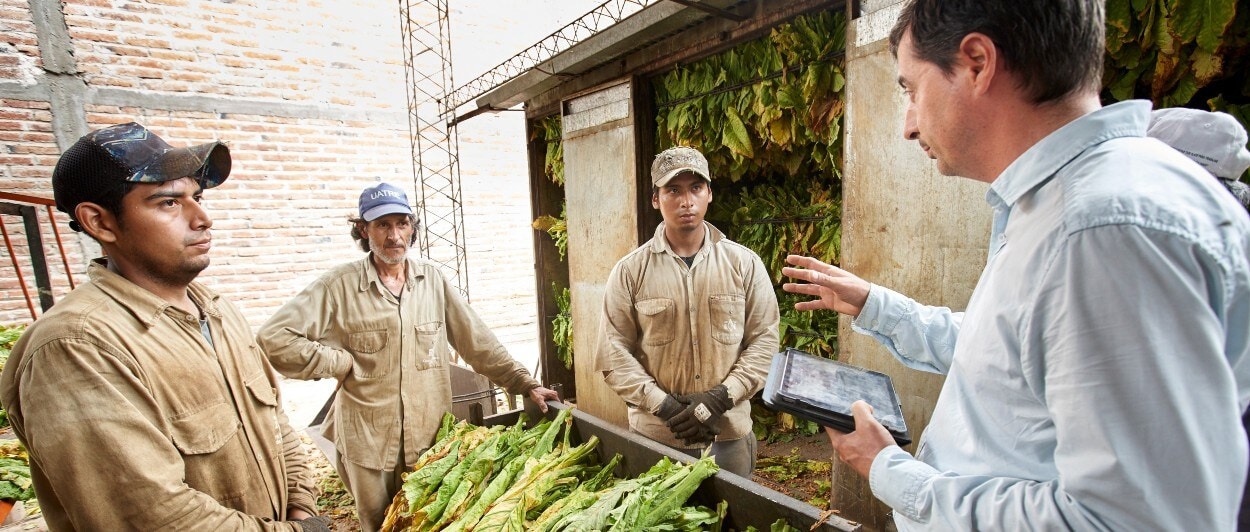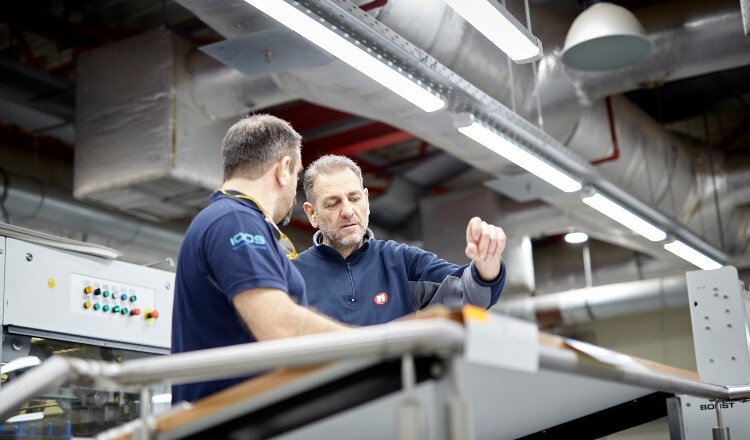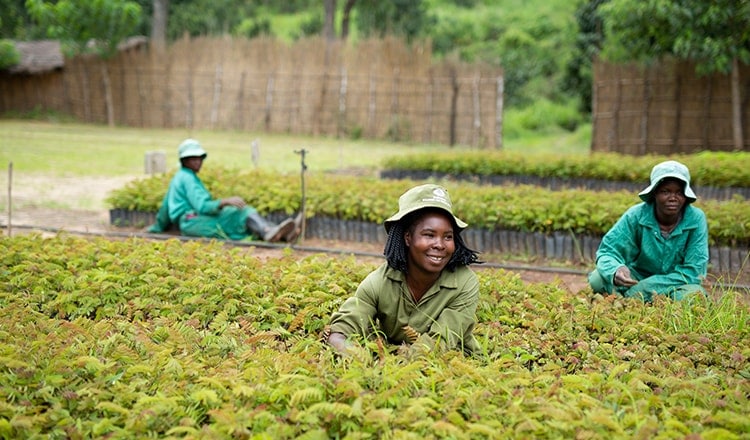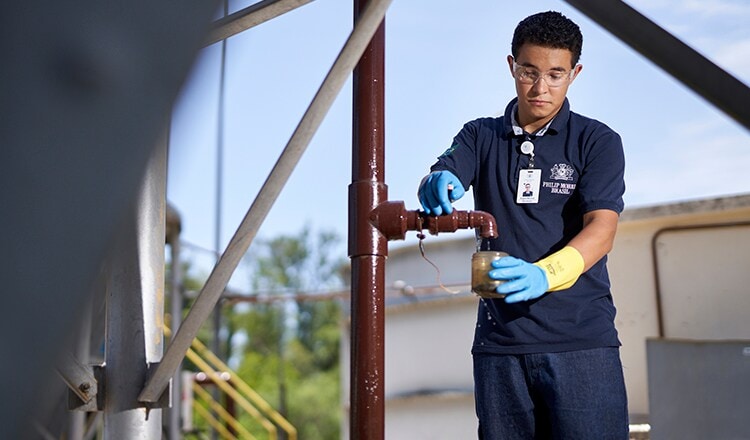| INTEGRATED REPORT 2019 |
The climate crisis affects ecosystems, agriculture, industry, finance, and people’s livelihoods.
Alongside physical impacts such as sea level rise and changing weather patterns, there are transition risks such as new carbon-related regulations and taxes, changes in manufacturing technology, and evolving consumer preferences. Being at the forefront of addressing the global challenge of climate change also presents opportunities. Some correlate to good practices such as energy-use reduction and the protection of forests and waterways; others arise through product eco-design and adaptation measures. PMI, alongside many of its suppliers, is working within a context of stabilizing the global temperature rise to below the internationally agreed 1.5-degree Celsius scenario.1 We understand the potential impacts of climate change across all areas of our operations, particularly upstream in our supply chain.
Why it is important to us and our stakeholders
The climate crisis, as acknowledged by the international community, threatens livelihoods, in particular of the most vulnerable people around the world. It impacts human population movement, biodiversity, access to water, global health, food security, and other environmental changes such as soil degradation and desertification.
Beyond its human repercussions, climate change threatens business continuity. This is especially the case for businesses involving an agricultural supply chain. For PMI, costs of raw materials such as tobacco leaf and cloves may rise, and both consumers and our employees are becoming increasingly sensitized to the environmental impact of corporate actions. Upfront investments with longer-term returns are required. Furthermore, the consequences of climate risk could expose investors to changes in corporate stock value.
At the same time, PMI’s efforts to reduce GHG, such as through increased energy efficiency, could alleviate potential costs and create a competitive advantage by meeting or exceeding the expectations of consumers, employees, and other stakeholders.
Achieving our aims
We aim to reduce our carbon emissions across our value chain. We have several programs in place to meet corporate targets and achieve our ambition.
In our Integrated Report 2019, we provide an update on progress made to achieve our current science-based targets, which align to a scenario for a 2-degree Celsius increase in global warming.
Our aims:
Net zero
Achievement of carbon neutrality of PMI’s direct operations (scope 1+2) by 2030
Net zero
Achievement of carbon neutrality of PMI’s value chain (scope 1+2+3) by 2050
At the same time, following the 2018 report by the Intergovernmental Panel on Climate Change (IPCC), it became clear that we must step up our ambition and reduce carbon emissions to align with the more prudent 1.5-degrees pathway. We also conducted a deeper analysis of our climate change risk assessment in line with the recommendations of the Task Force on Climate-related Financial Disclosures (TCFD). Based on these developments, we recently established new and more ambitious targets to guide our decarbonization journey:
PMI to be carbon neutral by 2030 (scope 1 and 2);
our whole value chain to be carbon neutral by 2050 (scope 1, 2, and 3);
a reduction in absolute CO2 emissions consistent with science-based targets for a 1.5-degree scenario.
During the course of 2020 we will submit our revised absolute reduction targets to the Science-Based Targets Initiative Committee for validation and report on progress in next year’s report. Our approach to decarbonizing our operations and value chain is guided by several corporate policies. Reducing our energy consumption and carbon emissions is embedded in our Environmental Commitment, our Guidebook for Success, our Responsible Sourcing Principles, and our Good Agricultural Practices program; protecting forests, as a fundamental climate-regulation mechanism, is directed by our Zero Deforestation Manifesto.
PMI’s governance and management systems aim to ensure that climate-related risks and opportunities are considered in relevant decision-making processes. The PMI Board of Directors (BoD) believes that environmental, social and governance (ESG) factors relevant to the company’s business, including those related to climate change, are important to PMI’s long-term success. These factors are part of the responsibility of the Board and are considered in its evaluation of the annual performance of the company and its management. The BoD approves the company’s annual budget and receives updates on its performance and targets against the budget throughout the year, including those related to the achievement of sustainability and climate protection targets.
The Nominating and Corporate Governance Committee of the BoD oversees PMI’s sustainability strategies and performance, including climate change-related issues and initiatives aimed at eliminating negative impacts of our business on the environment. The Audit Committee of the BoD oversees the assessment and management of company risks, including those related to climate change such as natural disasters, water scarcity, and agricultural supply chain instability.
We established new and more ambitious targets to guide our decarbonization journey.
As part of PMI’s risk management process, the Audit Committee oversees the management of climate change initiatives. A member of the Company Management, the Senior Vice President, Operations (SVP, Operations), was tasked with addressing climate change risk across all activities of the company, including physical climate and water-related risks. Our SVP, Operations reports directly to PMI’s Chief Operating Officer (COO) and is delegated with operational responsibility, including maintaining robust business resiliency, risk assessment processes, and strategies to support business continuity. Our SVP, Operations examines and monitors climate change-related issues, ensuring that risk assessment and management are integrated into long-range plans, objectives, budgets, and performance review processes. Our COO is also a member of PMI’s Company Management and reports to the CEO; he is updated regularly on climate change issues by the SVP, Operations. In 2019, the COO and SVP, Operations were the highest management level of climate related issues. They were responsible for monitoring and reviewing PMI’s objectives, strategies, and action plans related to climate change with the CEO, and they reported their findings to the Nominating and Corporate Governance Committee and Audit Committee of the BoD.
From an operational perspective, our Operations Sustainability and Corporate Sustainability functions coordinate the company’s climate change-related activities. Most of the coordination takes place in the context of sustainability working groups and with local market coordinators. This helps ensure that our global strategies and programs can be implemented at the market level and that local realities are reflected in our global efforts. Our tobacco leaf buyers, procurement managers, environmental managers, and other relevant employees are also incentivized through monetary rewards or other forms of recognition for emission reduction projects, climate change mitigation activities, and behavioral change toward climate protection. Our carbon footprint model accounts for emissions generated across our value chain. Accordingly, our strategy responds directly to the scale and expanse of our impacts, from our supply chains for tobacco and direct materials through to our operations, land and sea transport, distribution and retail, products, and packaging. Across our global operations and upstream in our supply chain, we have in place long-standing mitigation initiatives designed to reduce our carbon footprint.

Assessing climate change risks and opportunities
On top of the company risk management process described above, we periodically conduct a climate change risk and opportunities assessment to fully understand PMI’s impact across our entire value chain. This work aligns with international expectations such as the Paris Agreement to mitigate and adapt to climate impacts.
Scenario analysis formed part of the climate change risk and opportunities assessment we conducted in 2015 on physical risks and opportunities. Throughout 2018 and 2019, we updated that earlier risk assessment, accounting for changes in PMI’s footprint and business model. Our objective was also to further align our work and reporting with the recommendations of the TCFD, which aims to foster voluntary climate-related financial disclosures that provide clear, reliable, and useful information to the financial community.
The updated assessment identified climate change risks and opportunities (CCRO) that align with the TCFD transition and physical risk categorizations. Throughout this process, we mapped 149 CCROs across materiality and certainty and then divided them according to PMI’s risk categories: proactive, reactive, nonmaterial, watch, and potential quick wins, so we could better integrate them into the business. After further analysis, it was decided to prioritize the proactive CCROs, as they have the highest certainty and materiality levels. These results are discussed in more detail in our CDP submission, which can be found online.
The tables below highlight certain climate-related risks and opportunities, along with a description of how PMI is managing them based on the findings of our 2018–2019 assessment.
Climate change-related risks
| Key risks | Potential financial impact under the 2-degree scenario | How we address them |
|
Transition risk Our operations across the globe are subject to various climate-related regulations. There is a clear international trend toward stricter regulation, which could increase our operational costs. |
 |
Our energy management program, which includes energy consumption monitoring, as well as investments to improve energy efficiency, positions us well to manage these risks. |
|
Physical risk Changes in precipitation patterns and extreme variability in weather patterns could affect the yield, quality, and availability of crops such as tobacco and cloves, changing our buying patterns and increasing operational costs in the medium term. |
 |
PMI’s operations and supply chain are spread across geographies, mitigating the potential effects of severe catastrophic climatic disruption. Moreover, we have designed our business continuity management plans to mitigate the consequences of supply chain interruption and disruption. We conduct a global water risk assessment, complemented by local assessments in specific tobacco-growing areas, to mitigate risks in our supply chain. |
|
Transition risk Increased production costs for farmers in the supply chain due to changing input prices, specifically diesel fuel costs. For PMI, this has an impact on procurement expenditure on tobacco from third-party leaf suppliers and directly contracted farmers in the long term. |
 |
Since 2002, we have been implementing our GAP program, which includes mandatory requirements for our tobacco suppliers. The program provides specific guidance on initiatives to mitigate tobacco-growing risks and impacts related to climate change. Strategic initiatives include improving efficiency and switching to low-carbon energies. |
Climate change-related opportunities
| Key opportunities |
Potential financial impact under the 2-degree scenario |
How we seize them |
|
Compliance with and anticipation of future country-specific legislation provide PMI with the opportunity to reduce energy consumption, lower CO2 emissions, and reduce operational costs. This is embedded in our “zero-carbon factory” strategy, and annual and long-range plans to increase the use of renewable energy in our manufacturing sites through self-generation or purchases. |
 |
PMI’s strategy to achieve carbon neutrality in our direct operations by 2030 leverages various initiatives to eliminate losses and improve operational efficiency, as well as to increase the use of renewable energy. Options to self-generate or purchase renewable energy are evaluated at the local level. |
|
Accelerating the transition to a low carbon economy will likely require policy levers to reduce the cost of renewable technologies. This is likely to include subsidies for energy generation. Such policies are already a feature in many markets and are being used successfully to support the commercialization of renewable technologies, making them cost-competitive with conventional alternatives. |
 |
PMI’s strategy to achieve carbon neutrality in our direct operations by 2030 leverages various initiatives to eliminate losses and improve operational efficiency, as well as to increase the use of renewable energy. PMI uses a marginal abatement cost curve and internal carbon price to help prioritize projects for renewable energy generation and GHG reduction. |
|
As alternatives to fossil fuels become more readily available and cost comparable to their conventional counterparts, it becomes attractive for tobacco farmers to switch from fossil fuels to low-carbon energy sources. In addition to the change in fuels used, farms may become more efficient thanks to new technologies. If PMI continues to invest in programs to improve agricultural practices and encourage the uptake of low carbon equipment, contracted tobacco farmers’ expenditures on fuel and energy inputs will fall. |
 |
Since 2002, we have been implementing our GAP program, which includes mandatory requirements for our tobacco suppliers. The program provides specific guidance on initiatives to mitigate tobacco-growing risks and impacts related to climate change. Strategic initiatives include improving efficiency and switching to low-carbon energies. For instance, PMI supports contracted farmers in improving curing-barn efficiency and switching to renewables. |
1 Reference: ipcc
This online supplement to our integrated report should be read in conjunction with PMI’s Integrated Report 2019. The information and data presented in this online supplement cover the 2019 calendar year or reflect status at December 31, 2019, worldwide, unless otherwise indicated. Where not specified, data come from PMI estimates. See About this online supplement for more information. Aspirational targets and goals do not constitute financial projections, and achievement of future results is subject to risks, uncertainties and inaccurate assumptions, as outlined in our forward-looking and cautionary statements.





